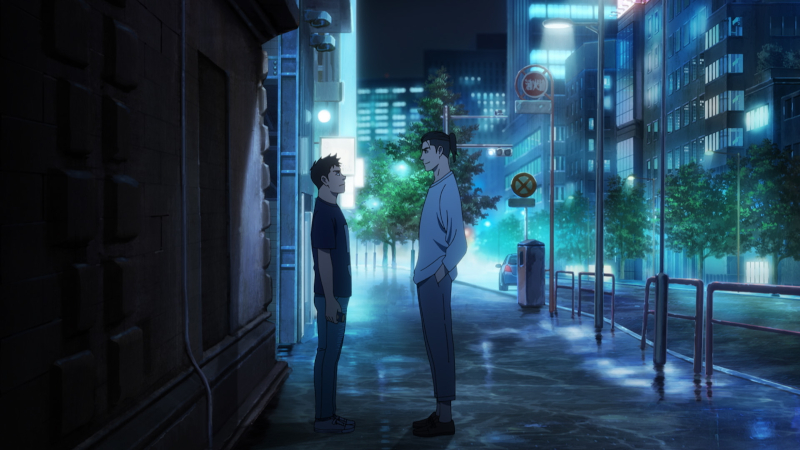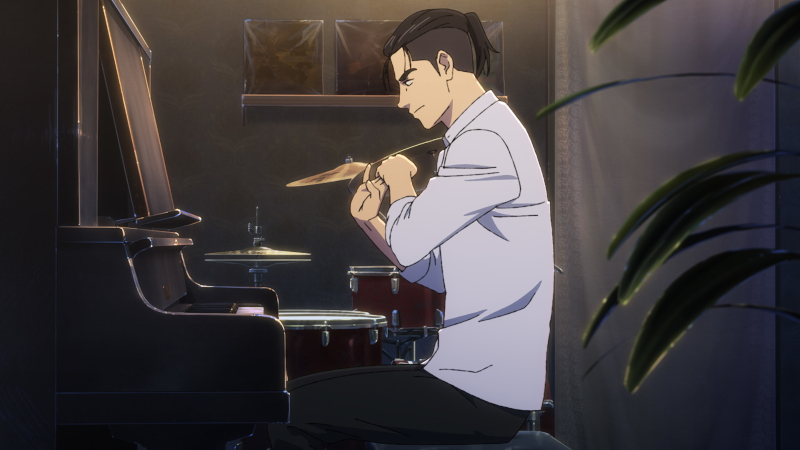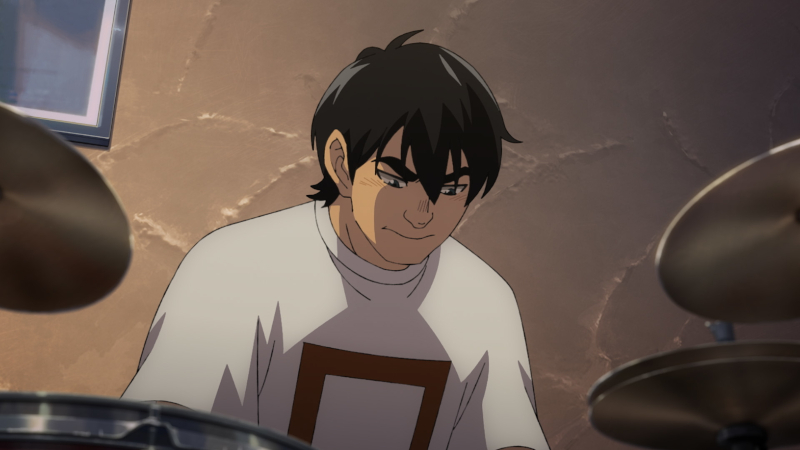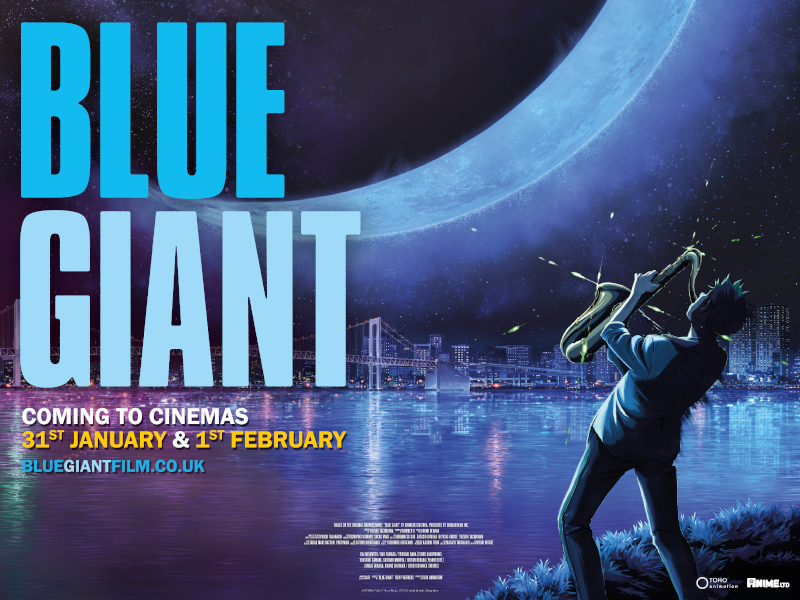Director – Yuzura Tachikawa – 2023 – Japan – Cert. 12a – 120m
*****
Three 18-year-olds form a jazz band with the aim of playing at Tokyo’s top jazz club – out in UK cinemas on Wednesday, January 31st and Thursday, February 1st
Before this property was a movie – an animated movie – it was a manga. Which, on one level, is nothing that out of the ordinary in Japan (see, for instance, basketball movie The First Slam Dunk, Takehiko Inoue, 2022) but on another is extraordinary. Blue Giant is about music, specifically jazz, even more specifically teenager Dai Miyamoto (voice: Yuki Yamada; musicianship: Tomoaki Baba) who gives up basketball and decides he wants to be the best tenor sax player in the world. He rehearses intensively by the banks of the river in the city of Sendai where he lives, leaving for Tokyo at age 18 and talking his way into moving in with old pal Shunji Tamada (voice: Amane Okayama; musicianship: Shun Ishikawa).

Unsure where to start, Dai visits a bar named Jazz – Take Two where the friendly Mama-san Akiko (voice: Sayaka Kinoshita), who no longer hosts live jazz gigs there, takes pity on him and plays him selections from her vast wall of jazz LPs. She is won over when he relates a piece of music to the time, place and weather – exactly the reason she had put it on the turntable – and sends him off to another venue where a jazz gig is in progress. He is taken with the playing of pianist Yukinori Sawabe (voice: Shotaro Mamiya; musicianship and the film’s musical director: Hiromi Uehara) who trades licks with the guitarist. Dai manages to talk to him at some length outside the club after the gig.

Surprisingly, Yukinori doesn’t care for the other three players. When Dai tells him of his own musical goal and asks Yukinoiri to team up with him in a band, the unsurprisingly sceptical Yukinori agrees to hear the 18-year-old play. Yukinori himself is likewise 18, although he has been playing piano since age four – his mother ran a conservatory where she tutored numerous piano students. Dai and Yukinori arrange an audition at Take Two, under the watchful, nurturing eye of Akiko, where Dai plays solo, and the suitably impressed Yukinori agrees to join forces with him.
As the two rehearse in Tamada’s flat, the latter – who has never played a note in his life – falls under the spell of jazz, tapping out rhythms on a Coke can with chopsticks. The duo need a drummer for their first gig, so Tamada is drafted in, learning to drum from the absolute basics and being given an Art Blakey CD as a learning aid by Yukinori. They use fliers to promote a gig, to which only four people turn up. Musically, though, it’s a success. After the gig, Yukinori tells Tamada his drumming included far fewer mistakes than Yukinori had expected. They coin the band name ‘Jass’ and aim to play a gig at SoBlue – the best jazz club in Japan.
A further gig follows at the Katsushiko Jazz Festival where it turns out they were booked by Amanuro, the leader of the headline act, who has never actually heard them play but understands there is a buzz about them. If anything, this motivates the three to play better than ever, the light playing off Dai’s tenor like cackles of electricity. They go down a storm, and one member of the audience – Isogai (voice: Masayuki Katou) from record label 21 Music, offers them a recording contract.

It emerges that Yukinori’s inspiration is a former girl pupil of his mother’s who used to play as if she were completely free of any worldly care, a condition to which he aspires in his own playing. As Yukinori talks with SoBlue owner Taira (voice: Hiroki Touchi), he learns the old man’s take on the band – the drummer (who can barely play) is endearing for his sheer effort, the sax is intriguing, but Yukinori’s playing, relying as it does on simple hand techniques, is no good. He tells the piano player that his answer to giving the band a gig is, “no”. And yet, when Taira later has a big name booked whose piano player is ill, the musician he calls upon to fill the slot is Yukinori, whose playing has improved, chastened by Taira’s admonition. Yukinori’s solo is a huge success, and Taira offers Jass a gig in four months’ time on the strength of his improved playing. However, when disaster strikes, Dai and Tamada decide to play the set as a two-piece.
Perhaps the surprising thing about all this is, thanks to the involvement of bone fida jazz musicians on the sequences where the characters play music, just how good that music is, something indicated by the fact that legendary jazz label Blue Note was prepared to release an album compiling music from the film and its Blue Note Tokyo club to host an evening if the music being played live.
And yet, watching the film, the performance segments are about far more than just the music – there’s always been a certain visual quality to watching musicians playing jazz, and in these sequences, the production team use a number of techniques to bring their images to life.

Manga author Shinichi Ichizuka and the film’s production staff opted for animation from the get-go since it was felt this would give, as the US press notes put it, the best possible sound quality and the maximum volume in theatres. Yet, it allows for something else, too. Different techniques are sometimes varied between one shot and the next. Thus, one shot feels in its movements like live action footage has been shot with a performer then rotoscoped (the technique of tracing off live action imagery to turn moving photographs into moving drawings, or animation). The next shot will be done using Motion Capture (MoCap), the technique originally made famous by live action film The Matrix (Larry and Andy Wachowski, 1999) as the basis for animation. And the next will be straightforward, 2D drawn animation.
Not that the film flags in the slightest when any of the musicians aren’t actually playing – Dai’s determination to be the best player he can be is strangely infectious and involving, Yukinori’s battling against his unconscious reliance on long-ago-learned musical techniques is similarly compelling, while utterly untutored Tamada’s attempts to learn and play the drums from scratch is, as per Taira’s observation, endearing because of the sheer will power and effort Tamada puts in. As the three pursue their seemingly impossible goal of a gig at SoBlue, the audience is swept along with their ambition, whether they cared about jazz before entering the cinema or not. For those audience members already attuned to jazz, the music itself is a bonus.
Altogether, a hugely enjoyable and immersive treat.
Blue Giant is out in cinemas in the UK on Wednesday, January 31st and Thursday, February 1st.
Trailer:
